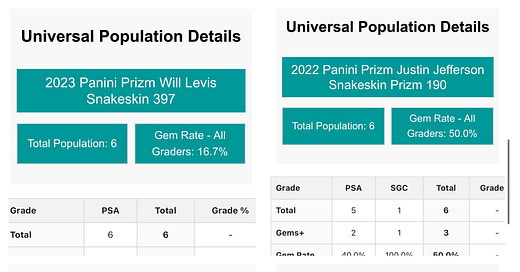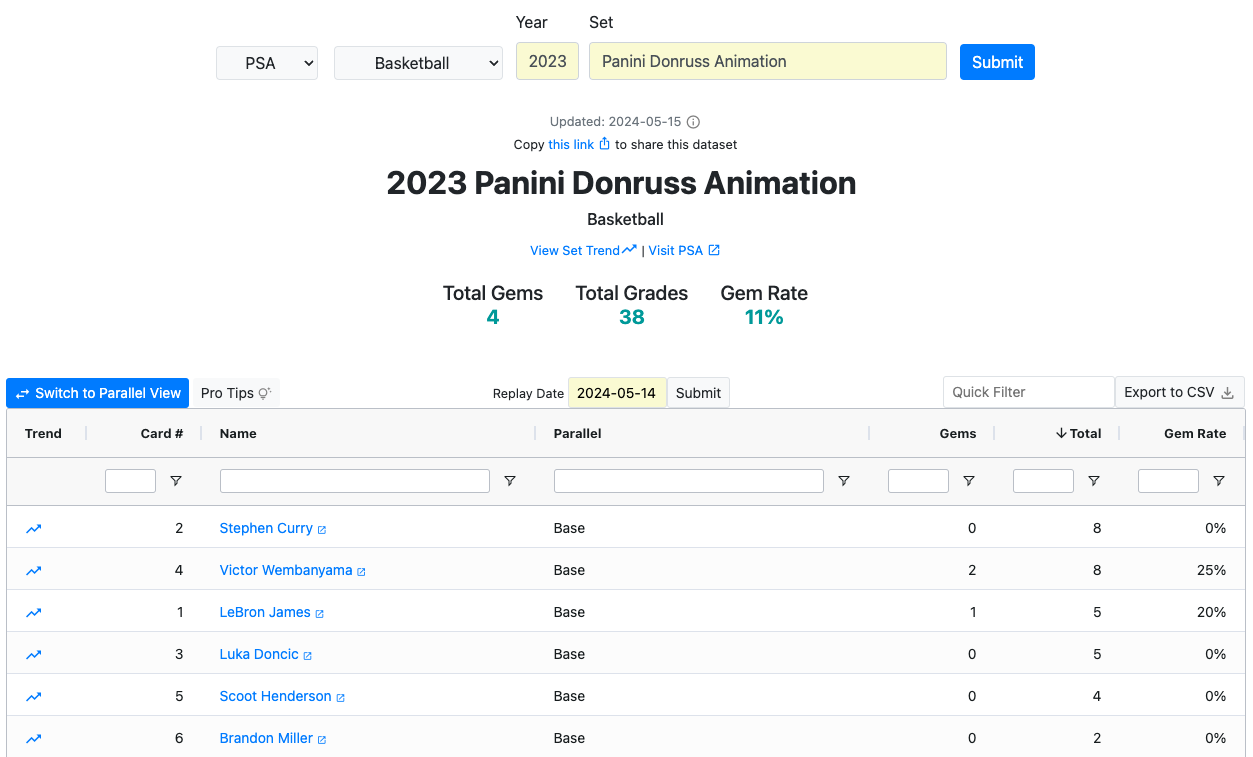How to tell if a card is really SP or SSP
Our hobby tends to be very loose with what we call an SP or an SSP. Without actually odds on packs, it's hard to say for sure, but population reports can help.
If you were to look through eBay listings, you would see that darn near every card is either a short print (SP) or super short print (SSP). While I’m sure some sellers use those terms as a way to try to get a bit more attention on their listings, I suspect many just heard something was hard to pull and genuinely thought it was one or the other.
Without proper odds on packs and boxes (hey there Panini) it’s hard to say definitely how rare something is or isn’t.
Blitz & Bones has been digging into grading population reports recently as a way to try to determine just how short print an insert is, and while it’s not a perfect approach, it’s probably the best option we have and I’ve been finding the results super interesting.
For example, one conclusion was that Prizm Snakeskins are legitimately a super short print, with no one showing up more than 20 times on the population report.
Or their example that Downtowns, a very popular chase card, are actually far from SSP this year.
I think it’s a really useful approach to trying to put a little bit of data behind the scarcity of a card. Here’s how you can use Gemrate (one of my absolute favorite resources) to figure it out.
For this example, let’s look at three animation-style insert releases from this year’s basketball products:
Hoops Presentations
Donruss Animation
Prizm Prizmania
All have been described at some point as SSP, but let’s take a look to see how scarce they each actually are.
My favorite way to do this is to use GemRate’s Set Breakdown as it let’s us see every card for a particular set.
First, we can do some level setting to make sure that it’s a fair comparison. Hoops has been out a lot longer than the other two releases, so it’s possible that there would be more cards graded in general.
Looking at the set breakdown, however, here’s how many total graded cards we see of each set:
Hoops: 22,304 cards
Donruss: 9,735 cards
Prizm: 44,839 cards
It looks like maybe Donruss might be at a bit of a disadvantage in our comparison, but certainly not Prizm. So when we look at the population for each of our three example inserts, if anything, we might expect more Prizmania to be found and graded than the others, with Animation potentially having the least.
Ok. Now the fun bit—let’s look at the actual inserts.
Hoops Presentations
First up, Presentations.
There are 3,288 graded Presentations cards, with the most popular (unsurprisingly Wembanyama) sitting around 574. Definitely not something we could call SSP.
Donruss Animation
Next up, let’s look at Donruss Animation.
This one looks a lot more rare, with only 38 total cards being graded. The most we see for any particular card is a whopping 8. It’s worth noting that Donruss in general had a lot less cards graded than the other two releases, so maybe that means there’s more to be found here. But even if we accounted for that difference, Animation would still be much more rare than the Presentations cards.
This one looks like a genuine SSP.
Prizm Prizmania
Finally, let’s look at Prizm Prizmania.
Here we’ve got 46 total graded cards, but a larger checklist than Donruss Animation—the most for any individual player so far is Curry at 6. Given the massive amount of Prizm cards graded, if this insert wasn’t a SSP, we would expect to see more of them here.
This one definitely qualifies as a SSP.
Ok…so what?
For what it’s worth, there’s no clear definition of what exactly qualifies as an SP or SSP. I do like Blitz & Bones suggestion of < 50 qualifying as a SSP, but it’s not like that’s been defined anywhere.
But I do think it’s worth double-checking sometimes when you see something listed as an SSP. I mean look—market value is market value: if everyone is paying for a particular card as if it’s an SSP and you really want that card in your collection now, then you might have to pay up too.
This data is still interesting to look at, though, because I think it can hint at what might happen to a card’s value over time.
If a card is carrying a SSP price premium, but you can see in the population report that it’s actually fairly widely distributed, the safest bet is that the premium is going to evaporate, at least a bit, at some point. Demand may be high, but so is supply and eventually that evens out.
If a card legitimately is an SSP, it seems more likely to hold onto a price premium for the long-haul. Even if that card is Prizmania and looks super goofy (opinions, I know), it’s likely that at demand will continue to be much higher than supply, perhaps even more so down the road.








